 |
Admiral Transistor 8 U.S.A. - 1959 |
 |
 Description
Description Restoration
Restoration |
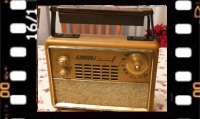 |
Descrizione
 Restauro  Schema elettrico |
|
|
|
|||
 |
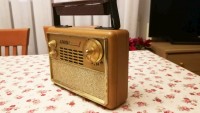 |
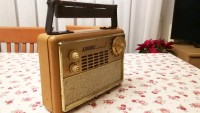 |
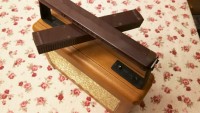 |
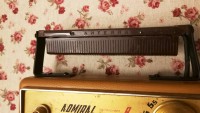 |
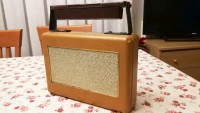 |
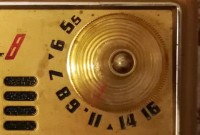 |
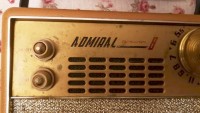 |
 Admiral Transistor 8 mod. 537 chassis 8L1 - Admiral Corp. 3800 W.
Cortland St. Chicago, IL - U.S.A. - 1959.
Admiral Transistor 8 mod. 537 chassis 8L1 - Admiral Corp. 3800 W.
Cortland St. Chicago, IL - U.S.A. - 1959.The company was founded in Chicago in 1934 by Ross David Siragusa, an entrepreneur of Italian origins (Sicily), with the name of Continental Radio and Television Corporation, and immediately began producing radio receivers and phonographs marketed under the ADMIRAL brand. In the second half of the 1950s, Admiral also began producing portable radios that used transistors, the new solid-state components that had quickly conquered the market. The Admiral brand characterized various models of portable radios of various sizes, characterized by solidity and excellent quality. The Admiral Transistor 8 mod. 537 was one of the successful models of the late 1950s. The size and weight of the 537 were considerable but were due to the elegant metal cabinet, the bulky 12 V battery that allowed a long operating autonomy and the presence of two speakers, a 4-inch one fixed on the front and a 3.5-inch one in the rear cover. The 537 was not stereo, but the push pull of 2N270 in class B provided 500 mW and by adjusting the tone control you could obtain a very pleasant "all around" sound reproduction. The radio received the Medium Waves from 535 to 1620 kHz and used a superheterodyne circuit with eight RCA germanium transistors: 2N140, 2N411, 2N139, 2N139, 2N406, 2N406, 2N270, 2N270 and a 1N295 germanium diode. The Intermediate Frequency resonated at 455 kHz, the sensitivity was remarkable and the antenna wrapped on a ferroxcube rod placed on the plastic carrying handle was rotatable (Radar-like) allowing to better tune the stations. The tuning knob was demultiplied and was located on the right side of the front panel, on the left side one above the other were the volume knob with power switch and the tone control. As on all radios built in the U.S.A. since 1951, the dial of the Admiral mod. 537 also features two small triangles corresponding to the two frequencies of the CONELRAD anti-atomic warning system. For more information on the subject, follow this Link. The power was supplied by a 12 V battery made up of 8 x 1.5 V C-type cells placed in series that allowed an autonomy of 1200 hours (as was written in the advertisement) obviously listening to the radio at a low volume. The dimensions were: 9.4 x 7.9 x 3.7 inch and the weight (with batteries inserted) was 5 lb 11.6 oz. © IK3HIA 2025. |
|||
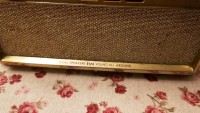 |
 |
 |
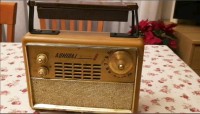 |
|
Back to the top of the page >>
|
|||
 Admiral Transistor 8 mod. 537 chassis 8L1 - Admiral Corp. 3800 W.
Cortland St. Chicago, IL - U.S.A. - 1959
Admiral Transistor 8 mod. 537 chassis 8L1 - Admiral Corp. 3800 W.
Cortland St. Chicago, IL - U.S.A. - 1959L'azienda fu fondata a Chicago nel 1934 da Ross David Siragusa, un imprenditore di origini siciliane, con il nome di Continental Radio and Television Corporation, e subito iniziò la produzione di radioricevitori e fonografi commercializzati con il marchio ADMIRAL. Nella seconda metà degli anni '50 anche Admiral iniziò la produzione di radio portatili che utilizzavano i transistor, i nuovi componenti a stato solido che in breve tempo avevano conquistato il mercato. Il marchio Admiral caratterizzò vari modelli di radio portatili di varie dimensioni contraddistinte da solidità e ottima qualità. L'Admiral Transistor 8 mod. 537 fu uno dei modelli di successo della fine degli anni '50. Le dimensioni e il peso della 537 erano notevoli ma erano dovuti all'elegante mobiletto metallico, alla voluminosa batteria da 12 V che permetteva una lunga autonomia di funzionamento e alla presenza di ben due altoparlanti, uno da 10 cm fissato sul frontale e uno da 3,89 cm nel coperchio posteriore. La 537 non era una radio stereo, ma il push pull di 2N270 in classe B forniva 500 mW e regolando il controllo di tono si poteva ottenere una riproduzione sonora "all around" (tutto attorno) molto piacevole. La radio riceveva le Onde Medie da 535 a 1620 kHz e utilizzava un circuito supereterodina con otto transistor al germanio della RCA: 2N140, 2N411, 2N139, 2N139, 2N406, 2N406, 2N270 e 2N270 e un diodo al germanio 1N295. La Frequenza Intermedia risuonava a 455 kHz, la sensibilità era notevole e l'antenna avvolta su bacchetta di ferroxcube posta sulla maniglia per il trasporto di materiale plastico era girevole (Radar-like) permettendo di sintonizzare al meglio le stazioni. La manopola della sintonia era demoltiplicata e si trovava sul lato destro del pannello frontale, sul lato sinistro una sopra l'altra erano situate la manopola del volume con interruttore di accensione e quella del controllo del tono. Come su tutti gli apparecchi radio costruiti negli U.S.A. a partire dal 1951, anche sulla scala parlante dell'Admiral mod. 537 sono impressi due triangolini in corrispondenza delle due frequenze del sistema di allarme antiatomico CONELRAD. Per maggiori informazioni sull'argomento seguire questo Link. L'alimentazione era fornita da una batteria da 12 V formata da 8 celle tipo C da 1,5 V poste in serie che permettevano un'autonomia di 1200 ore (così era scritto sull'annuncio pubblicitario) ovviamente ascoltando la radio a volume non elevato. Le dimensioni erano: 24 x 20 x 9,5 cm e il peso (con batterie inserite) era di 2.6 kg. © IK3HIA 2025. |
|||
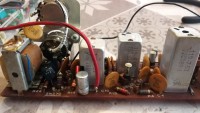 |
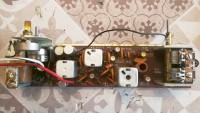 |
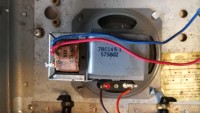 |
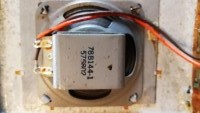 |
|
Back to the top of the page >>
|
|||
 Restoration.
Restoration.The Admiral mod. 537 serial number 42624 arrived with the metal cabinet in fairly good condition, with the golden parts not corroded and the metal grills that protect the speakers not broken. Unfortunately the rotating antenna made of old and fragile plastic material had been destroyed, a piece of the support on which the rotating part was hinged was still there, but the two lateral supports were missing of which only a few fragments remained. The seller had kindly provided me with some of the pieces and also a sheet of paper on which the colors and destinations of the 4 connecting wires between the antenna and the circuit had been noted. Before proceeding I tried to power the radio to see if it showed signs of life. Of course I did not immediately supply 12 V, but using my multi-voltage power supply I powered the old receiver with gradually increasing voltages. I started from 1.2 V going up to 6 V. With 6 V the Admiral started to show some signs of life, the volume potentiometer creaked and the speakers made some hiss. With 9 V I managed to tune a station on Medium Waves. After 66 years the radio was still trying to work so it deserved to be restored. After thinking about how to solve the antenna problem I went to a hardware store where I bought a flat bar of one meter of aluminum measuring 20x2 mm, with which I intended to prepare two shaped brackets to screw to the upper part of the radio and to the remaining piece of the antenna. Using the two-component epoxy glue I put the upper support of the antenna back together. While the glue was drying (epoxy glue takes about eight hours to harden completely) I cut with the hacksaw, drilled holes and bent to size two pieces of the aluminum bar and covered them with two pieces of black heat-shrink tubing. The next day I fixed the new brackets with screws and nuts to the top of the radio, and to the antenna support with four self-tapping screws. You can see how the work turned out in photo 4. There was still a gap of 66 years to overcome, during which some of the radio's components had certainly deteriorated. The Admiral was a receiver that in 1959 cost a whopping $69.95 (about $730 today) so it had to be treated with care. After examining the wiring diagram, I decided to replace the five electrolytic capacitors in the circuit with modern components, but to avoid clashing I had to use the old aluminum cases. I emptied the old capacitors and "filled" them with modern components of equal capacity and higher working voltage that were much smaller, then I re-soldered them on the circuit. The next job was to put the old radio battery holder back into service. Leaving zinc carbon batteries unused in a battery holder is always harmful and unfortunately this also happened to the Admiral Transistor 8. It was therefore necessary to file down corroded contacts, remake others with pieces of copper but at the end I managed to restore the contacts and be able to insert eight 1.5V C-type batteries into the battery holder. The last operation was to perform a general internal and external cleaning of the cabinet using cleaning wipes stolen from my wife and to use the deoxidizing spray on the two potentiometers. After reassembling everything and inserting the batteries, I turned on the 537, tuned in the strong signal of the private station that transmits at 1017 kHz in my area. The reception was strong and clear and I did not consider it necessary to proceed with the alignment of the various radio frequency stages, so I recorded a short video and the Admiral mod. 537 became an honorable part of my collection of transistor receivers. © IK3HIA 2025. |
|||
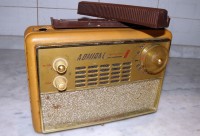 |
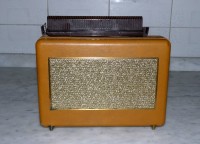 |
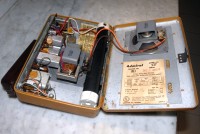 |
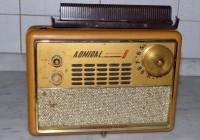 |
|
|
|||
 Restauro
RestauroL'Admiral mod. 537 matricola 42624 mi è pervenuta con il mobiletto metallico abbastanza in buono stato, con le parti dorate non corrose e le griglie metalliche che proteggono gli altoparlanti non sfondate. Purtroppo l'antenna girevole realizzata con vecchio e fragile materiale plastico era andata distrutta, un pezzo del supporto su cui era imperniata la parte girevole c'era ancora, ma mancavano i due sostegni laterali dei quali erano rimasti solo pochi frantumi. Gentilmente il venditore mi aveva fornito una parte dei pezzetti e anche un foglietto su cui erano stati annotati i colori e le destinazioni dei 4 fili di collegamento tra antenna e circuito. Prima di procedere ho provato ad alimentare la radio per vedere se dava segni di vita. Naturalmente non ho fornito subito i 12 V, ma utilizzando il mio alimentatore multitensione ho alimentato il vecchio ricevitore con tensioni via via crescenti. Sono partito da 1,2V salendo fino a 6V. Con i 6 V la Admiral ha iniziato a dare qualche segno di vita, il potenziometro del volume scricchiolava e dagli altoparlanti usciva del fruscio. Con 9 V sono riuscito a sintonizzare una stazione in Onde Medie. Dopo 66 anni la radio tentava ancora di funzionare perciò si meritava di essere restaurata. Dopo aver pensato a come risolvere il problema dell'antenna mi sono recato da un ferramenta dove ho acquistato una barra piatta da un metro di alluminio delle dimensioni 20x2 mm, con la quale avevo intenzione di preparare due staffe sagomate da avvitare alla parte superiore della radio e al pezzo rimanente dell'antenna. Utilizzando la colla epossidica a due componenti ho rimesso assieme il supporto superiore dell'antenna. Mentre la colla si asciugava (la colla epossidica impiega circa otto ore a indurire del tutto) ho tagliato con il seghetto, forato con il trapano e piegato a misura due pezzi della barra di alluminio e li ho ricoperti con due spezzoni di guaina termorestringente nera. Il giorno dopo ho fissato le nuove staffe con viti e dadi al lato superiore della radio, e al supporto dell'antenna con quattro viti autofilettanti. Dalla foto4 è possibile vedere com'è venuto il lavoro. Rimaneva da superare il gap di 66 anni, durante i quali sicuramente alcuni componenti della radio si erano deteriorati. La Admiral era un ricevitore che nel 1959 costava ben 69.95$ (circa 730 dollari attuali) perciò bisognava riservarle un trattamento di riguardo. Dopo aver esaminato lo schema elettrico, ho deciso di sostituire i cinque condensatori elettrolitici presenti nel circuito con componenti moderni, ma per non stonare dovevo utilizzare i vecchi involucri di alluminio. Ho svuotato i vecchi condensatori e li ho "riempiti" con componenti moderni di pari capacità e maggiore tensione di lavoro che avevano dimensioni molto inferiori, poi li ho risaldati sul circuito. Il lavoro successivo è stato quello di rimettere in servizio il vecchio portabatterie della radio. Lasciare inutilizzate le pile zinco carbone dentro un portabatterie è sempre deleterio e purtroppo questo è successo anche alla Admiral Transistor 8. E' stato necessario pertanto limare contatti corrosi, rifarne altri con pezzetti di rame ma alla fine sono riuscito a ripristinare i contatti e poter inserire nel portabatterie otto pile tipo C da 1.5V. L'ultima operazione è stata di effettuare una pulizia generale interna ed esterna del mobiletto usando delle salviette detergenti rubate a mia moglie e di usare lo spray disossidante sui due potenziometri. Rimontato il tutto e inserite le batterie ho acceso la 537, ho sintonizzato il forte segnale della stazione privata che nella mia zona trasmette a 1017 kHz. La ricezione è stata forte e chiara e non ho ritenuto necessario procedere all'allineamento dei vari stadi a Radio frequenza, così ho registrato un breve video e la Admiral mod. 537 è entrata a far parte con onore della mia collezione di ricevitori a transistor. © IK3HIA 2025. |
|||
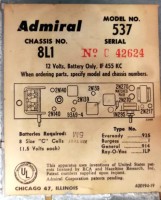 |
 |
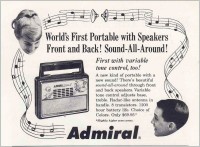 |
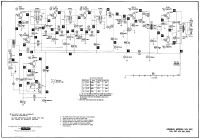 Schematic diagram |
|
Return to top of page
|
|||
|
|
Return to: IK3HIA home page |
|
Return to: Transistor Radio |
|
Go to: Transistor diagrams |